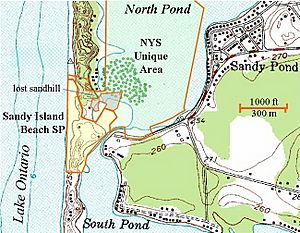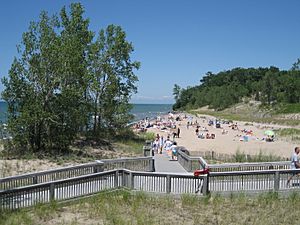Sandy Island Beach State Park facts for kids
Sandy Island Beach State Park is a beautiful park located on the eastern shore of Lake Ontario in New York. It's famous for its amazing natural sandy beach, which stretches about 1,500 feet (457 meters). This park is part of a special 17-mile (27-kilometer) stretch of sandy shoreline, dunes, and wetlands along Lake Ontario. Experts have called this area home to some of the best beaches and wildlife habitats on the entire lake.
The park offers many fun things to do. You can swim in Lake Ontario, with lifeguards on duty during the summer. There are also changing rooms, restrooms, and a snack bar. A small fee is charged for parking in the summer. Around 30,000 people visit the park each year to enjoy its beauty.
The park has grown over time. Before 2011, it was about 13 acres (5.3 hectares). Next to it was the 120-acre (49-hectare) Sandy Island Beach Unique Area, a protected natural space. In 2011, both areas joined together under the New York State Office of Parks. Now, Sandy Island Beach State Park covers a total of 229 acres (93 hectares) in the Town of Richland, Oswego County.
Contents
Discover Sandy Island Beach History
How Sandy Island Beach Became a Park
In the 1950s, Sandy Island Beach started as a private beach resort owned by LeGrande and Eva Smith. It quickly became a very popular spot. People called it "the hottest spot on the shoreline" in the 1960s. Many families loved visiting this lively place.
After LeGrande Smith passed away in 1966, the resort became less popular and closed in the early 1970s. The area started to look run down. In 1980, Ed Wyroba and Dyke Riggs bought 450 acres (182 hectares) of the old resort. They reopened it in 1981 and ran it until 1991.
Protecting the Beach for Everyone
To protect this special place, The Nature Conservancy stepped in during 1999. They worked with Oswego County and New York State to buy the remaining 133 acres (54 hectares) from the Riggs family. The Conservancy then gave 13 acres (5.3 hectares) of the beachfront to Oswego County to create a park. New York State bought 120 acres (49 hectares) for the Unique Area.
Oswego County managed the beach for several years. They built new facilities like a bathhouse, picnic areas, and a boardwalk. In 2005, the County Park became part of the New York State Park system. This means it is now protected and managed for everyone to enjoy.
Explore Sandy Island's Amazing Sand Dunes
Understanding Coastal Dunes
North and south of Sandy Island Beach, you can find tall sand dunes. Some of these dunes are up to 50 feet (15 meters) higher than Lake Ontario! Even though they are made of pure sand, trees like red oak and red maple grow on them. These forested high dunes are quite rare along the eastern Lake Ontario coast. It can take hundreds of years for a forest to grow on a new sand dune.
How Dunes Can Change Quickly
One high dune just north of the park shows how quickly sandy landscapes can change. Years ago, a popular spot on the beach was a tall sandhill that overlooked North Pond. A map from 1958 shows this dune was at least 50 feet (15 meters) high. However, by the 1980s, a local newspaper reported a "monster" dune moving towards Sandy Pond. The sandhill that was once so tall is now much lower, becoming a "low dune."
Protecting Dunes with Plants
Stable coastal dunes are built and held together by special plants. These include beachgrass and cottonwood trees. The tall dune that disappeared likely did so because its plants were destroyed. This happened especially in the 1970s when the area was private and not looked after. People driving dune buggies, trucks, and motorcycles, and having bonfires, destroyed the plants that held the sand in place.
Since 2000, New York State has worked to rebuild parts of the dune overlooking Sandy Island Beach. They have replanted it with beachgrass. At the nearby Sandy Pond Beach Unique Area, similar replanting efforts have helped low sand dunes grow back. While these efforts are successful, it's thought that the very tall dunes might not grow back to their original height naturally. Experts say that conditions are no longer right for maintaining such high dunes.



